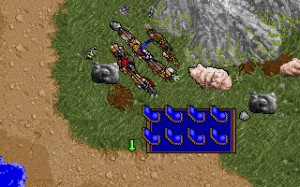A few weeks ago I posted rules for cantrips for all the 4e Players Handbook classes: I thought that every class should get the benefit of out-of-combat abilities that a) defined the class and b) spurred creativity.
Today I’ll do the same thing for the classes from the Player’s Handbook 2.
The PHB 2 is a challenge: half of its classes are old favorites with well-established conceptual niches (bard, barbarian, druid, and sorcerer), and half are experiments whose flavor provides varying levels of inspiration (invoker, shaman, avenger, and warden.) Some of the newer classes are difficult to design for because I don’t have an intuitive feeling about their out-of-combat activities. In some cases, I made up new flavor.
AVENGER: Avengers are scary dudes. Their deal is that they threaten people. Before they kill you, they let you know that they are GOING to kill you. The Oath of Enmity is a very flavorful class feature: all avenger cantrips need to do is tie some noncombat mechanics to the Oath of Enmity.
Reminder of Enmity: Just because you’ve survived a combat with an avenger doesn’t mean you’re off the hook. Anyone who was ever subject to an Avenger’s Oath of Enmity, in combat or out, is subject to frequent reminders of the fact.
An Avenger may send a vision to anyone who was once subject to the Oath of Enmity. The vision is typically of a) the avenger, b) a bloody weapon, or c) the avenger killing the subject with a bloody weapon. If the subject is sleeping, the vision will be woven into a dream. Each day, the Avenger may send one vision per level, but no more than one per day to each subject.
BARBARIAN: People do not play barbarians because they want cantrips. They play a barbarian because they want to smash things. So I’ll stick to basics.
I Hit It With My Axe: In one action, an armed barbarian can automatically destroy any inanimate object that another character might destroy in a minute. This includes almost all furniture, wooden doors, art, and stone walls less than 6 inches thick. If a barbarian destroys a large item, its square becomes difficult terrain. This action is extraordinarily loud.
I Hit Them With My Axe In one action, a barbarian destroys any number of fragile items within weapon reach. This action is also extraordinarily loud.
BARD: Historically, why have people wanted to play bards? It’s not because of how awesome they are in combat. It’s because they sing and annoy everybody. Bards are all about performance, and while they have a few music-related attack powers, it is really out of combat that they get to fulfill the promise of their class.
Perform: As a standard action, the bard plays an instrument or sings. Until the end of the bard’s next turn, all willing listeners enjoy themselves. (There are no game statistics behind this, but NPCs tend to seek out enjoyment unless there is a reason not to.) During the performance, willing listeners suffer a -2 to perception checks.
Compose: The bard writes a song and Performs it for at least a dozen strangers. The song becomes a well-known standard in the nearest city. (At bard level 11, the song is known country-wide, and at level 21, continent-wide.) People tend to believe the message of the song unless they have a reason not to. Be careful with the slander – if anyone is offended by the song, they’ll be able to get a description of the original performer.
DRUID: The druid schtick is a defender of the wilderness. In my experience, druid players often want to behave like eco-terrorists, despite the fact that there is no real need to protect wilderness in a medieval or points-of-light setting.
Grow: As a standard action, the druid may make small plants spring up in an adjacent square. The druid may make a square difficult terrain, or cause climbable ivy to appear on a wall. Furthermore, by concentrating, a druid can cause ivy and roots to do 1 HP damage per minute to adjacent stone structures. The druid cannot grow cultivable plants like grain, and cannot grow plants in barren areas where they would not normally grow.
Command Animals: As a minor action, a druid can command a small natural creature, like a mouse or bird, in a burst 5, to do a simple task. Keeping the animal’s attention on the task requires a sustain minor. The animal cannot communicate with the druid except with very simple sign language, conveying “finished”, “impossible,” “I’m scared and need a pep talk” and similar messages.
INVOKER: The Invoker description suggests that Invokers know some purer form of divine magic than clerics do. Their cantrips should feel like sparks from the living steel of Creation itself. Invokers should also be able to do things that make clerics jealous.
Word of Creation: The gods can alter reality with a single word. Invokers have a shred of that power.
The Invoker can utter the name of a nonliving object small enough to be held or worn. It will appear in the character’s possession. Sustain minor. It disappears when the invoker speaks any other word at all (or casts a spell). The object can be up to 5 feet in its largest dimension (at level 11 it can be up to 10 feet; at level 21, 20 feet). The DM should be careful to make sure that the character doesn’t speak while the object is sustained, or the object will vanish. The Invoker can’t be too specific in his or her invocation: he or she can only utter a single noun, not describe an object. However, the DM should generally honor the player’s intent and not try to subvert the cantrip with wilful misinterpretation.
I’m curious if this cantrip is too powerful: I’d like to see it in play. People don’t play invokers that often, though, so I might never get to playtest it.
SHAMAN: Out of combat, the shaman schtick is that they talk to spirits. In combat, the shaman is the guy who summons a giant bear to eat enemies. The giant-bear part generally overshadows the talks-to-spirits part, which is a shame because there is room in the D&D world for a shaman who is attuned to the messages of the spirit world. No NPC wilderness tribe should be without one. I tried to come up with cantrips that would let NPC shamen do the things you’d expect them to do: mutter to invisible creatures, pronounce taboos, and give mystical, yet maddengly nonspecific, guidance to PCs.
Commune with Spirits: As a standard action, the shaman talks to the weak spirits in the area. They can unerringly answer any of the following questions:
-What is the last creature or group to have passed, and what did they do? Spirits have no sense of time, and no sense of of the purpose behind any activity.
-Is there currently anything that disrupts the natural order around, and in what direction? Aberrant, undead, and extraplanar creatures disrupt the natural order. A town doesn’t necessarily disrupt the natural order, but a sanctified temple does, because it is blessed with astral energy. A cleric doesnt, but a zone from a clerical spell does. Most arcane magic does not, but eladrin teleportation might, because it connects the world with the feywild. Spirits do not distinguish between good and evil, but they do give an indication of the strength of the disruption.
-How may I end a magical effect? As a healer in touch with the spirit realm, the shaman can gain unique knowledge about ending curses and other magical effects. Any temporary or permanent magical effect may be banished, even those associated with magic items, curses, and magical diseases. The DM should come up with an appropriate rite to end the effect. To banish a magical zone in combat, it might take a round or two of ritual dancing and the expenditure of some ritual ingredients. To end a magical curse or destroy a magic object, it might require a quest of varying difficulty. The way to accomplish the quest might be clear or unclear (ranging from “fetch mountain moss to put on the wound” to “sacrifice 50 cattle” to “fly through a keyhole at the western corner of the world”.)
Materialize: The shaman makes a local spirit visible to all, in glowing form, with the luminosity of a candle. Sustain minor. The shaman can also make invisible or ethereal monsters visible to all.
SORCERER: A sorcerer is like a wizard who wields raw, barely contained magic. I thought it would be fun to use the same cantrips as wizards, but in undisciplined, destructive forms.
The player is in control of the cantrip. It’s up to the player if the character is in control too; the cantrip’s effects might be latent expressions of the sorcerer’s unconscious power.
Ghost Scream: Like Ghost Sound, but it can only produce the kinds of unsettling noises that would freak you out in the dark.
Lightning Flash: Like the Light cantrip but it provides light in irregular bursts of lightning (accompanied by thunder if the player wishes). It provides strobe light in an 8 square radius. Everyone in strobe light has partial concealment (-2 to attacks), and Hide attempts may be made.
Mage Slap: Someone feels a pinch, slap, or tug from an unseen hand.
Polterdigitation: Something fragile is destroyed in a flashy way. Glass might shatter, or papers might be thrown around the room. Light objects might be thrown harmlessly. An object might be stained with blood. Special: three effects may happen per turn.
WARDEN: The warden is very difficult for me to get a handle on. As far as I can tell, a warden is like a druid who fights with a melee weapon: or maybe more like a magical ranger. (Of course, in some editions, rangers can already cast spells.) There’s not enough of a niche for me to hang much conceptual baggage on. I decided to do my best to add some class flavor with the Sentry Tree power.
Sentry Tree: As a standard action, the warden turns into a tree (it’s the same tree each time). This can only be done in an environment where trees may grow. It takes a standard action to change back. As a tree, the warden is able to see in all directions, and 6 hours as a tree counts as an extended rest. As wardens get older, they often spend more and more time as a tree, and they age as a tree ages; many old oaks and willows are wardens of ancient days who might, in times of need, return to their original forms. (If you want, you can add 1-100 years to your character’s starting age).
The last warden cantrip is interesting mainly in that I wrote it on a laptop on which the F key didn’t work, and it is thus extremely hard to read.
eed: cause any nurturing plant to put orth ruit. the ood lasts or ive minutes. I eaten in that time, the ruit will provide sustenance or the ull day.











